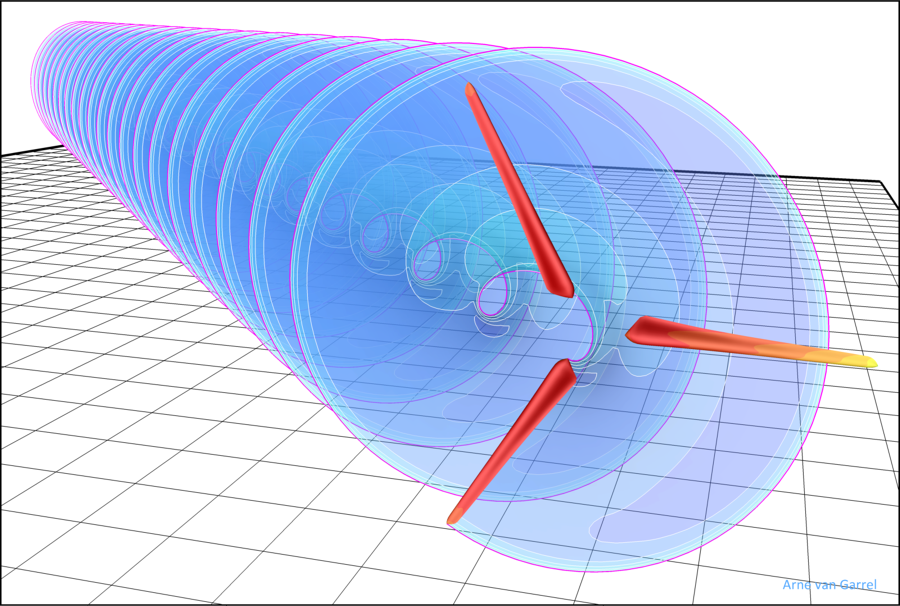University of Twente doctoral candidate Arne van Garrel has developed a computational method to make the design process for wind turbines faster and more efficient.
His PhD research may well provide an important link in the transition to renewable wind energy. Arne is an ardent advocate of wind power, which he believes to be both the cheapest and most promising energy source of the future.
The yield of a wind turbine depends directly on the diameter of the rotor blades, with increasingly large rotor blades as a result. A reliable prediction of the energy yield and the forces acting on the construction of a wind turbine is an essential part of the design phase. Manufacturers are keen to obtain the most accurate picture of this yield as quickly as possible.
Century-old method
To make these calculations, an accurate prediction of air flow around the rotor blades is required. Existing computer models often take months to come up with an answer and use up a lot of processing power. Moreover, the interpretation of the results requires time and expertise that is seldom readily available in an industrial design environment. The alternatives include diverse and simplified methods which date back to the 1920s, devised in Germany shortly after World War I.
Plane method for wind turbines
In his thesis, Arne points out another option. “The panel method, introduced for aircraft in the 1960s, has fallen into neglect but could in fact be extremely useful in the design of wind turbines. It’s a matter of combining it with a highly efficient computational method. My aim was to come up with an approach that occupies the middle ground between a traditional and a more intensive method. I wanted to model the physics, but without taking too much simulation time. Preferably the results should be available within a day.”
150 times faster
Arne explains that the panel method only requires a description of the surface of the wind turbine. “This makes it possible to quickly define a new blade design and carry out numerical simulations,” he says. The calculation method he has developed in his PhD research is 150 times faster than the conventional panel method. “My method involves modelling the flow around the rotor blade, while dispensing with the effect of air viscosity. However, it does give me all the available information on the forces acting on the rotor blade and aerodynamics, facilitating a better blade design.”
Arne compared his evolved panel method with the results of pressure measurements on a three-bladed wind turbine in a test carried out at a DNW wind tunnel in the Noordoostpolder region. He also compared his method with an accurate but computationally costly simulation method developed by the Netherlands Aerospace Centre. The differences were negligible. Arne also conducted experiments in the wind tunnel at the University of Twente.

Image: Visualization of wakes for wind turbines with a yaw angle of thirty degrees.
Arne van Garrel
Arne van Garrel first came up with the idea for his research in 2009 when he was still working at the Energy Research Centre of the Netherlands (ECN). “I was interested in taking a more in-depth approach and was keen to do more research. I started studying for my PhD in the evenings. Incidentally, it’s not an approach I would recommend to anyone: I was working day and night!” Harry Hoeijmakers and Kees Venner, University of Twente professors in fluid mechanics and also his supervisors, later offered him a PhD position at Twente.
Alongside Professor Venner, Arne now lectures on wind energy within the programmes Mechanical Engineering and Sustainable Energy Technology.
His PhD research is also assessed by Professor Mark Drela of the Department of Aeronautics and Astronautics at the MIT in the US, one of the world’s foremost technology institutes.
Arne is a keen supporter of multidisciplinary research into wind energy: “The unique combination of science and social studies research at the University of Twente creates an ideal environment for such a broad-based approach.”
Arne van Garrel defends his thesis entitled Multi-Level Panel Method for Wind Turbine Rotor Flow Simulations at 16.45 on 14 December in the Waaier building on the University of Twente campus. A digital version of his thesis is available on request.
Arne’s research is part of the Department of Engineering Fluid Dynamics (Faculty of Engineering Technology) and Science-Based Engineering.





